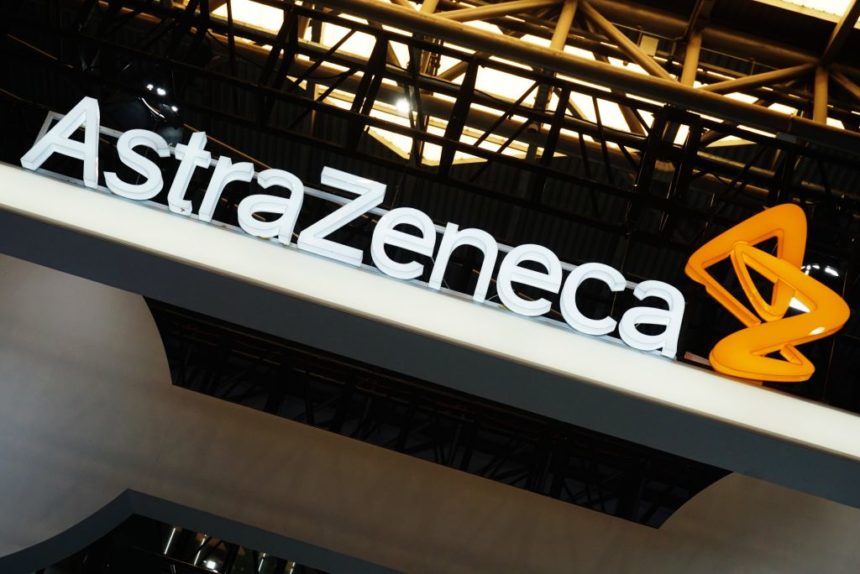AstraZeneca’s tyrosine kinase inhibitor (TKI) Tagrisso holds a commanding position as a first-line treatment for EGFR-mutant non-small cell lung cancer.
However, initial data suggest that the company’s flagship brand, which is also being tested along with chemotherapy in that setting, could face competition from Johnson & Johnson’s own pairing of bispecific Rybrevant with TKI lazertinib.
Treatment with Rybrevant/lazertinib led to a median progression-free survival (PFS) of 23.7 months versus 16.6 months for Tagrisso monotherapy – a difference of 7.1 months. That’s according to an early release of late-breaking abstract data on Tuesday from J&J’s head-to-head MARIPOSA trial by the European Society for Medical Oncology (ESMO).
The combo also showed a 30% reduction in risk of disease progression or death versus Tagrisso alone.
The question now becomes, can Rybrevant plus lazertinib capture a substantial portion of the first-line EGFR-mutant NSCLC market?
Analysts say the answer depends, to a large extent, on how the Rybrevant-based pairing fares in an efficacy comparison against Tagrisso plus platinum-chemotherapy.
Earlier this week, the Food and Drug Administration greenlit the drugmaker’s priority review application for the Tagrisso/chemo regimen in treatment-naive EGFR-mutant NSCLC. That was based on data from AZ’s FLAURA-2 trial, which demonstrated a roughly nine-month PFS benefit for the combo versus Tagrisso alone. The U.S. regulator is expected to render a decision early next year.
A lung cancer faceoff emerges
There’s a lot on the line for both AstraZenecaand J&J. Tagrisso represents AstraZeneca’s most lucrative product, representing 12% of 2022 revenues at $5.4 billion. Much of that is derived from its use in treating first-line metastatic disease and FLAURA-2 seemed to set a new efficacy bar.
First line represents 55% of all metastatic NSCLC patients, per AstraZeneca estimates cited by SVB Securities. Of those, AstraZeneca estimates about 13,000 U.S. patients are EGFR-mutant.
Rybrevant, for its part, has accelerated approval for second-line treatment of EGFR-mutant NSCLC. At a list price of around $261,000 for 12 months of treatment, expanding the drug’s addressable population into the first line could unlock multiple billions in incremental Rybrevant revenue, plus sales from lazertinib.
If MARIPOSA fails, analysts expect combined revenue potential for Rybrevant/lazertinib to be in the $1 billion to $3 billion range, based on sales in the EGFR exon20 NSCLC cohort, which represent about 5% to 10% of EGFR-mutated NSCLC, plus lazertinib monotherapy sales.
AstraZeneca fortifies base
Given the potential threat from J&J, it’s no stretch to say that AstraZeneca wouldn’t mind solidifying its position.
In late September, about a month after AstraZeneca released its combo data at the 2023 World Conference on Lung Cancer, J&J announced positive topline results for the head-to-head phase 3 MARIPOSA study.
In prior commentary, J&J management had talked up the disruptive potential of the Rybrevant-based pairing in the first-line EGFR-mutant NSCLC treatment landscape. The late-breaking ESMO data, however, suggest that its clinical profile “meets the lower end of our threshold that would suggest the combination…carries a clinically meaningful difference,” wrote Goldman Sachs analyst Salveen Richter in a Wednesday note to investors.
Indeed, many had hoped the MARIPOSA delta would exceed the 9.5 months achieved in FLAURA-2, especially given Rybrevant requires IV dosing and Tagrisso is a more convenient oral formulation.
In that sense, J&J’s data were “underwhelming,” wrote SVB’s Andrew Berens in an investor note.
“Based on this dataset, we do not see widespread adoption of the MARIPOSA cocktail in 1L NSCLC,” Berens added, “given the necessary tradeoffs in quality of life and dosing complexities versus oral Tagrisso.”
Another consideration is whether J&J’s cocktail has a manageable safety profile relative to Tagrisso monotherapy. Adverse events seen in MARIPOSA were higher for the J&J regimen than for Tagrisso alone.
That said, analysts expect there to be plenty of debate around how MARIPOSA’s 7.1-month PFS benefit compares to AZ’s FLAURA-2 Tagrisso plus chemo combo’s nine months.
Interim overall survival (OS) was not yet statistically significant, but showed a non-statistically significant trend in favor of Rybrevant + lazertinib versus Tagrisso.
A stronger signal on OS could drive usage, although analysts anticipate a portion of the market may opt to remain on monotherapy Tagrisso and save Rybrevant for second-line therapy, especially given the extra toxicity relative to lazertinib or Tagrisso alone.
Indeed, overall success of the combination regimen must “take into account the totality of clinical data – efficacy, safety, as well as administration convenience – in the assessment of whether Rybrevant plus lazertinib will be able to capture a substantial portion of the 1L EGFR-mutant NSCLC market,” Richter stressed.
To that end, analysts await the full MARIPOSA readout, in particular safety results, slated for Monday at ESMO. In addition, a subcutaneous version of Rybrevant – due to debut in second-half 2024 – could offer greater tolerability and convenience than the IV version studied in MARIPOSA.
Merus Pharma is testing its own bispecific cancer drug, MCLA-129, in combination with Tagrisso in the first-line EGFR NSCLC setting. Data are expected at the ESMO Asia congress in December.
For a February 2024 post on Tagrisso plus chemo being approved in U.S. for lung cancer, click here.








